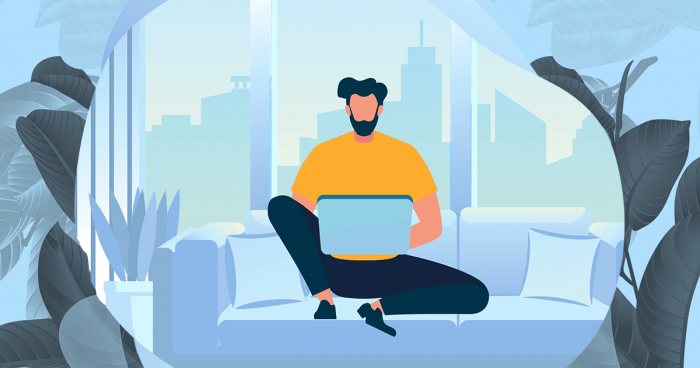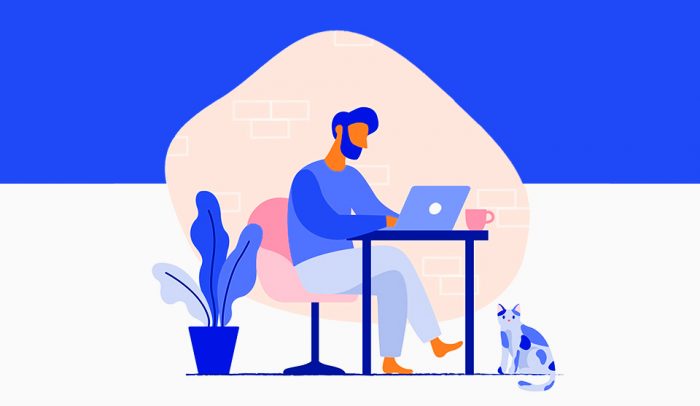When America began sheltering in place in March, there was an anticipatory buzz across the more optimistic corners of the Internet—this was going to be a time of immense productivity. Forbes touted the benefits of becoming a “coronapreneur,” and DIY home improvement supplies were selling out. For creatives, in particular, there was a sense that this could be a long-sought rainy day—an ideal time for both lofty ambitions like home remodeling and for more attainable ones like organizing files in Illustrator. We’d know how to be productive.
But the stress of the pandemic has had a more significant effect on workers than originally anticipated, especially those who are left to supervise their children’s education, and the economic fallout has left a lot of freelancers worried about their next paycheck.
But designers still have work to do, and we wanted to find out how they were getting it done. We spoke to a few artists and designers to hear some of their creative solutions for dealing with the pandemic blues and harnessing their productive power—for their day jobs or side hustles—during quarantine.
Picking up new skills, shedding old habits
While nonessential businesses are shuttered and the streets are quiet, there’s no better time to learn a new creative skill. “It’s a good opportunity to teach yourself a new software or computer skill if that’s something that interests you,” said Vincent Fileccia, an NYC-based brand designer at online bank Current. When he’s not on deadline for Current, he’s doing just that—teaching himself how to use the web building tool Webflow. “Learning how to use Webflow has been exciting,” he said, “because I can take this going forward and use this tool with other clients.”
LA-based artist and designer Faye Orlove has also been spending time in self-quarantine working on her software skills, and recommends the digital illustration tool Procreate, for those with an iPad. She also redid her website and organized her files: “my desktop has never been so tidy!” she wrote in an email.
Designer and illustrator Naomi Otsu has also been turning to illustration while sheltering-in-place—and she’s found a funny trend in the work that she’s been producing. While she’s always been drawn to anthropomorphizing in her work—she said it’s “kind of my thing”—she’s found that self-quarantine has left her seeing faces everywhere: “Maybe it’s a weird imagining of my friends, the people around me, living things around me, because everything is so quiet,” she said.
Brooklyn-based freelance illustrator Carolyn Figel has similarly chosen to focus on her craft—but rather than going the software route, she’s been drawing by hand. “I think people assume that illustrators draw everything from hand,” she said. “And I was getting more embarrassed with how much I don’t really do that anymore.”
To brush up her skills, she started using oil pastels to draw the same thing every day: a portrait of her face. “I don’t know what’s going to come of it,” she said of her daily project. “I think that’s the best part—I have no plan for it. I just know that it makes me feel good, and so I just keep doing it.”
Making time to be inspired
Inspiration comes easily when we’re moving through the world. Random encounters and experiences—an arc of a vaulted ceiling, that particular shade of pink of Tennessee marble in Grand Central—can spark a designer’s creativity. But those exciting “a-ha” moments don’t come as easily when you’re on the couch all day.
Fileccia has struggled to find inspiration being stuck at home. “I’m immersed in my phone’s choices rather than being inspired by the things around me,” he said. “Because everything is within my own little space, it’s a lot more limited in terms of what I’m discovering.”
Fileccia’s advice is to make sure that you’re mixing up your routine and getting time off-screen. “It’s important to step outside of design,” he said. Similarly, Otsu has been finding her inspiration away from the computer. “I don’t really browse Instagram a whole lot for graphic inspiration,” she said. “Ideas usually come to me when I’m just sitting alone in bed. There’s been so much silence in my life now, empty time that I would be filling up a lot more if this wasn’t happening. I think time and space has allowed me to connect the dots and get inspiration from within.”
UX designer Jason Muxlow, from Austin, Texas, has also also been gleaning inspiration from outside of his normal routine—resurfacing unfinished music projects and digging into books and movies. He recommends The War of Art, by Steven Pressfield, Gary Hustwit’s documentary Helvetica, and Linotype: The Film.
Staying sane, one task at a time
Whether you’ve been working from home for years or you’re just getting into the swing of it now, you know that the ticket to productivity is a tried-and-true routine. Figel explains how a structured schedule focused on just a handful of projects has helped her maintain a productive workday in self-isolation: “I have noticed that I’ve been being diligent with a few projects—that I started when this happened—as a way to stay sane a little bit.”
For Figel, her sense of productivity derives from her morning routine. “Waking up at a set time helps,” she said. “Exercising every day helps. If you have a mask and you’re comfortable with going outside for a walk, that helps, as well.” Orlove has the same advice for other creatives—for her, a flexible daily routine is the ultimate key to self-motivation in quarantine. “Set up a routine for yourself that feels challenging but comfortable,” she wrote in an email. “Stop sleeping in, get a good coffee you like, and take breaks when your body is telling you it needs one.”
Fileccia stressed the importance of open communication in terms of staying on track with deadlines. “Being a designer, it’s so important to collaborate with other people,” he said, “and so communication has been a big focus, especially with my clients—really over-communicating as much as possible.” He also explained that, during self-quarantine, he’s gotten really into fitness. “It feels like a little bit of a challenge to myself,” he said. “That helps me break a routine that I’ve had.”
One thing that helps Figel stay on track is to set aside a little time to take stock of the day and see what worked. “I just check in with myself,” said Figel, “and reflect on what was important to me that day.”
Volunteering their creative eye
For many artists or designers, this has been a moment of feast or famine. As Figel explained, while she’s had a steady stream of projects come her way, a lot of the publications that she usually works for have had their budgets cut. Orlove similarly expressed that as a freelancer, “no one is hiring as funds are tight, so ‘non-essential’ art projects seem to be put on hold.” These are tough times.
While there’s no solution to the uncertainty that comes with an economic recession, artists who have the time and social following—including Figel, Orlove, and Otsu—have been using their personal platforms to help fundraise and support community efforts.
“I think accurate information is really important in this day and age,” Otsu said. “I want to talk about more serious subjects or information that people might need.” She’s spending her free time making infographics that are both informative and also delightful. “I think people are inclined to share it more if it looks nicer,” she said of her images. “People are drawn to fun looking things. And how we can communicate in the best way is the challenge right now.”
For almost each day of the quarantine, Figel has also used her Instagram as a place to keep her skills sharp. “It’s a little more of a comic-book style,” she said about her project. “It’s just like things that happened that day or things that I just wanted to remember about this time.” It also has functioned as a space to raise awareness—from fashionable COVID-19 masks to raising funds for NYC’s Food Bank.
Looking to volunteer your skills? Try these tactics:
- Join the 1,000 volunteers designing to combat COVID-19.
- Design merch—the way that DS Projects has been doing—to support your local small businesses.
- If you have a background in industrial design, you could help create door hacks and produce creative masks.
Watch out for burnout
Between volunteering in your free time and juggling various personal and professional projects, the days can fill up pretty quickly. It’s just as important to your overall productivity to make time for activities that aren’t related to work at all. Orlove explains that it doesn’t matter what you do in your freetime, so long as it’s bringing you pleasure. “Now is not the time to worry about ‘what’s cool,’” Orlove said. “Just find stuff you like and get busy with it.”
Figel agreed that in quarantine, there shouldn’t be any judgment for how breaks are spent. “If you just need a day of lying on your bed and staring at your phone, that’s fine,” she said. She recommends staving off burnout by trying a workout from Trill.fit, following the artists Jordan Ferney and Grace Miceli on Instagram, and indulging in pictures of Arnie the dog as the ultimate act of self-care.
Otsu has similarly found that her workflow has had to adapt to the new realities of work-life balance. “I can’t work as much because I’m just so stressed out all the time, and I have to remind myself that that’s okay,” she said. “I think everyone needs to be constantly reminded that they need to be gentle with themselves.”
The trick to staying self-motivated, Figel explains, is to stay flexible. She tries to avoid getting too rigid or deadline-oriented when the pressure is on. “The thing that I’ve struggled with the most is like how to push yourself to get things done but not beat yourself up when you don’t get everything done on your list,” she said. “There have been days where I’ve missed it, and I just have to be like, ‘It’s fine. I’ll catch up tomorrow.’”
Otsu wonders if this moment of self-quarantine will have a permanent impact on the way that designers are treated by their clients. “The creative process and good things take time,” she explained. “Hopefully the industry also recognizes that shift and is a little kinder to designers going forward.”



